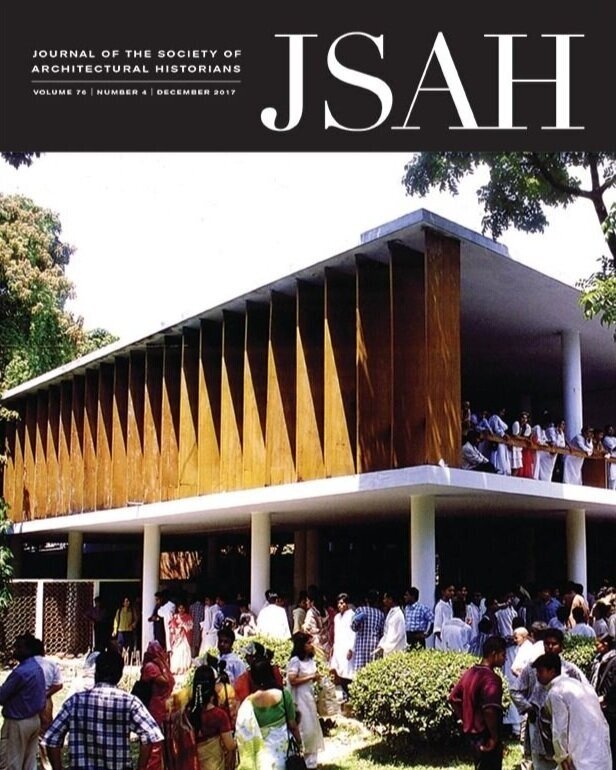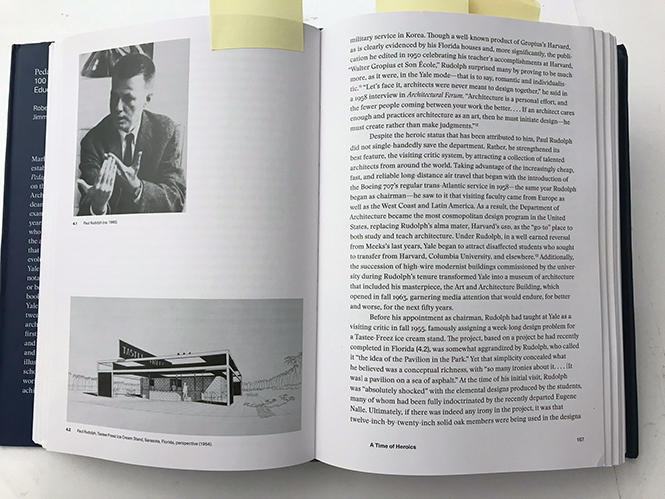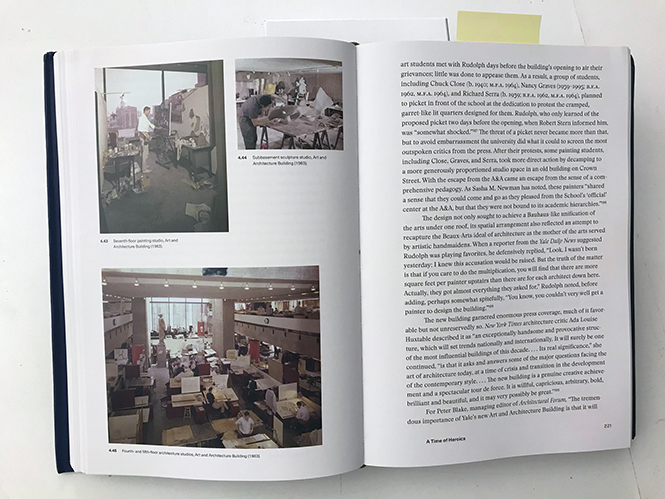Saturday, 3:38 AM, July 14, 1969 — the moment that New Haven police were alerted that the Yale Art & Architecture Building was on fire. The blaze was quickly contained, but serious damage —from fire, smoke, and water—extended across several floors of Rudolph’s most iconic building.
When we say that someone’s “on fire”, it usually means something positive— that they’re in a state of great productivity, or they’re achieving their goals, or they’re becoming famous—or sometimes all of those. In that sense, the late 50’s and the 1960’s was certainly a period when Paul Rudolph was “on fire”: important commissions—often large scale, with significant budgets, and in a variety of building types—were coming into the office in abundance, and Rudolph was creating some of his most iconic buildings.
Rudolph was widely published, and seen as the face of a lively and creative American Modernism—and in 1957, at age 39, he was appointed Chair of the school of architecture at Yale (taking office in 1958). Soon after his appointment, he was given the commission to design Yale’s new Art & Architecture Building.
In February, 1964. something occurred which had probably never happened in the history of architectural publishing (and may never happen again): All three major American architectural journals—Architectural Record, Architectural Forum, and Progressive Architecture—had the same building as their cover story: Rudolph’s Yale Art & Architecture Building. John Morris Dixon, an editor at Progressive Architecture at the time, told us that there was no coordination for this—and, given that magazines generally avoid covering the same projects (and would certainly never want to make the same project their “cover story”), it is all-the-more evidence that this building was powerful enough to warrant such across-the-board coverage.
Rudolph’s Yale A&A Building on the cover of the February 1964 issue of ARCHITECTURAL FORUM
Rudolph’s Yale A&A Building on the cover of the February 1964 issue of ARCHITECTURAL RECORD
Rudolph’s Yale A&A Building on the cover of the February 1964 issue of PROGRESSIVE ARCHITECTURE
Reports on the building were nearly ecstatic—and the venerable critic Sibyl Moholy-Nagy—whose Modernist credentials could not be questioned—had an essay in Architectural Forum that can be taken as emblematic of the design’s initial reception. With insight and numerous historical references, she plumbed the building’s formal and spatial roots—and offered some qualifications—but her overall assessment was glorious. Here ae some of her remarks:
Architectural Forum’s February 1964 issue gave extensive coverage to all aspects of the Yale building. Shown here is a page from that issue, with Rudolph’s famous perspective-section drawing, as well as the main floor plan.
“It is gratifying to know that the world of academic honors and medals has so profusely acknowledged the Bauhaus doctrine of architectural education as taught at Harvard since 1937; because never before has a curriculum turned out such a star roster of infidels. Johnson, Lundy, Barnes, Rudolph, Franzen, and others have revered their teacher [Gropius—ed.] while confounding his teaching. They all have left the safe anchorage of functionality, technology and anonymous teamwork to start the long voyage home to architecture as art. A few faithfuls still repeat the old incantations, but the guns by which they struck have stopped firing while those of the apostates are blazing.”
“. . . . [Rudolph’s] latest building. It is a splendid achievement, crystallizing potential solutions for some of the most vexing propositions facing architecture today.”
“The concrete surface has been widely criticized as being arty in an age of technology. However, the visual relief from the beton brut cliché of random formwork in the wake of Le Corbusier's revolution is so pleasing, and the purpose of the building so nontechnological, that the artifice seems wholly justified.”
“Space is an abstraction that must be conceived for its specific purpose. Every user is a judge. It is from their total involvement in this dichotomy of idea and realization that the architectural students will learn the essence of their profession. The Yale school is Paul Rudolph's confessional proof that architecture is not a commodity but an infinite potential of art, and therefore free and imperishable.”
“Earthrise”—probably the most famous photograph to come out of the US space program. The photo was taken in 1968 during the Apollo 8 mission—the first time a manned ship had gone to the moon-and-back.
GOOD TIMES, AND…
After 6 years as chair, during which he revolutionized architectural education at Yale, Rudolph left in 1964—relocating his home and office in New York City (where he’d reside for the rest of his life). The later 60’s continued to be a good period for him, and in a previous article we surveyed how a representative year—1968—was both a time of cultural and political churning in the country, and a creatively rich time for Rudolph.
Things were going well in the US economy, and technology and culture [including architecture] were advancing in multiple directions—but that cultural & political “churning” (referred-to above) also involved protests of increasing number and intensity: of the war in Vietnam, the lack of rights for Women and minorities, the devastation of the environment, and of inequalities in wealth and community resources.
The Yale’s Art & Architecture Building’s main atrium drafting room, after the 1969 fire. The space’s signature statue of Minerva, though streaked by smoke, was undamaged.
…FIERY TIMES
Moreover, the very consumer/conformist culture which was so celebrated in mainstream media—and the values on which it was founded—were being questioned by a younger (and increasingly activist) generation. This led to campuses ablaze with protest.
The 1960’s—with all its growing openness and freedoms, as well as its clashing bitterness—is the subject of numerous historical-cultural studies, and has been dramatized in literature. For our purposes, we just want to note that it is within this heated atmosphere that Rudolph’s Yale Art & Architecture Building caught fire.
[RETROSPECTA 40 (the 2016-2017 issue), published by the Yale School of Architecture, has a section on the campus cultural context within which the fire occurred—as does Robert A. M. Stern and Jimmy Stamp’s history of a century of architectural education at Yale, “Pedagogy and Place” (which also covers the fire’s aftermath).]
Paul Rudolph, in the uniform of an officer in the US Navy during World War II. He was stationed at the Brooklyn Navy Yard, and engaged in the repair of damaged ships.
DID RUDOLPH CAUSE THE YALE A&A FIRE?
Rudolph left Yale in 1964, and his stated reason was to deal with his expanding professional practice—and, given the number and complexity of the commissions he was receiving, one can see that as a legitimate reason. Yet there may be an additional cause—emerging from Rudolph himself.
The sensitive and reticent country fellow, who went into the Navy during World War II, emerged as an experienced 0fficer who had commanded hundreds, working in a navy yard on the repair of damaged warships. Rudolph retained that mood and mode of command for the rest of his career. Even his look changed: gone was his pre-war bouffant, replaced by a severe flat-top cut that he wore for another half-century. While he was capable of showing warmth and generosity, he was known to students, faculty, and employees as a leader who was assertive and demanding. This brought forth superb achievements from students and staff—and often evoked life-long appreciation and loyalty to Rudolph—but, as the 60’s got going, the culture was changing: anything that had an authoritarian feel was ripe for questioning and push-back. Perhaps Rudolph began to feel this—and wanted none of it. So 1964 was the right time for him to depart.
Moreover, Rudolph’s own building—his great legacy to Yale—conveyed that same feeling of forcefulness. By the later 60’s, it too was being questioned—both functionally and conceptually—with its almost aggressive use of materials and “overdetermined” spaces were being undermined by the way it was used (and, some say, abused) during the chairmanship of Charles Moore, Rudolph’s successor as chair.
So if there was on-campus anger in the air (directed at a menu of legitimate grievances), there was also anger at the building—or rather, what it represented: power and authority, and the society (the campus and beyond) in which that was solidified and wielded.
Rudolph may have been gone, but his building felt like a tangible manifestation of what was wrong with the world.
The photographer of this scene, taken within Yale’s Art and Architecture Building in 2008, labeled it as having “crowded desks” and “littered with food, models, draft designs, and instruments of architectural design”. The studios in 1969—also a time of widespread smoking—were even denser with combustible materials.
WHAT REALLY CAUSED THE YALE A&A FIRE?
Many causes were advanced for the fire. Several that have been put forth are:
The boiling, angry atmosphere, in that era of campus protest, was the context for student acts of violence and possibly arson.
The above—a period of profoundly “anti-establishment” (anti-authoritarian) protest—combined with the almost aggressively powerful character of Rudolph’s design, made the building itself an attractive target for a protesting act of destruction.
The building was permeable, and known to be subject to occasional petty theft, so local “kids”—delinquent teenagers—have been alleged to have started the fire.
The studios were allowed—during Moore’s chairmanship—to become “favelas”: divided up by makeshift partitions of highly combustible materials—an environment of tinder, and in an era when smoking by students and faculty was still prevasive.
The materials used by students—-paper, cardboard, glue, brushed and sprayed paint, wood, rubber cement…—are highly flammable. Moreover, as anyone who has ever visited an architecture school studio will report, these environments often become anarchic with scraps and debris on every surface.
Investigations of the fire were conducted, but never identified a distinct culprit. The local fire marshal said the cause was “undetermined” and possibly accidental, and cited the mass and density of combustible materials—but the local fire chief publicly said it was “of suspicious origin".
The Yale Art & Architecture Building did eventually receive a thorough renovation (and upgrading of systems), and was rededicated as Rudolph Hall in 2008.
REBIRTH OF THE PHOENIX
When Rudolph was asked about his reaction to the fire, he said:
“I felt as if somebody had died.”
Others reflected on the fire as symbol and message. A student said:
“. . . .the building burst into flames out if its own psychic guilt. It was the only solution.”
Peter Blake—an architect, journalist, and architectural magazine editor (and friend of Rudolph) wrote:
“The Yale fire did dramatize a state of concern. . . .a profound uneasiness among students (and some faculty) about the priorities that today govern American architecture and American architectural education”
In the fall of 1988, Yale students created an exhibit about the building—one to which Rudolph gave his full cooperation (including lending drawings.) The catalog had essays by Alan Plattus, George Ranailli, and Thomas L. Schumacher—each expressing their insights about (and appreciation of) the building—but the contribution by the late Michael Sorkin, “Auto da Fe”, meditated on the fire, and ends by evoking the mythical and immortal phoenix bird that regenerates out of fire:
“Too soon, but not too late for the Phoenix. The ruin waits to blaze again.”
The fire left the building was unusable, and the school had to move-out while repairs were done—not returning until 1971. Even without the fire, Rudolph had not been happy with way the building had been left subject to poor maintenance, and allowed to fall into disrepair. This was compounded by the way the subsequent administration (Moore’s) seemed to encourage a disrespect for the building and the values—Rudolph’s values—it represented. It was many years before Rudolph would even visit the building.
The building continued to decline, and Yale even considered demolition. Fortunately, it eventually received a complete and respectful interior & exterior renovation, undertaken with the support of Sid R. Bass (for whom Rudolph had designed an elegant residence, as well as other projects)—and in 2008 it was rededicated as
RUDOLPH HALL
Another view, taken after the 1969 fire, showing internal damage to the Art & Architecture Building. When Rudolph later remarked about his reaction to the fire: “I felt as if somebody had died.”
IMAGE CREDITS
NOTES:
The Paul Rudolph Heritage Foundation gratefully thanks all the individuals and organizations whose images are used in this non-profit scholarly and educational project.
The credits are shown when known to us, and are to the best of our knowledge, but the origin and connected rights of many images (especially vintage photos and other vintage materials) are often difficult determine. In all cases the materials are used in-good faith, and in fair use, in our non-profit, scholarly, and educational efforts. If any use, credits, or rights need to be amended or changed, please let us know.
When/If Wikimedia Commons links are provided, they are linked to the information page for that particular image. Information about the rights for the use of each of those images, as well as technical information on the images, can be found on those individual pages.
CREDITS:
Yale Art & Architecture Building, during the 1969 fire: courtesy of Yale University; Photo of earth from space: photograph by US astronaut William Anders; Covers of the February, 1964 issues of Architectural Forum, Architectural Record, and Progressive Architecture, courtesy of USModernist Library; Yale Art & Architecture section and plan: page from Architectural Forum, courtesy of USModernist Library; Interior views of the Yale Art & Architecture Building, showing fire damage: courtesy of Yale University; Rudolph in US Navy officer’s uniform: © The Estate of Paul Rudolph, The Paul Rudolph Heritage Foundation; Renovated Yale Art & Architecture Building (Rudolph Hall): photo by Sage Ross, via Wikimedia Commons; Studio interior, within the Rudolph Hall (the Yale school of architecture building): photo by Ragesoss, via Wikimedia Commons







































![A chart from the Pew Research Center’s study of Public Trust in Government: 1958-2019 The overall downward trend, from 1964 to the present, is evident. [Note that the largest and steepest drop was in the wake of the mid-1970’s Watergate scandal.] Wh…](https://images.squarespace-cdn.com/content/v1/5a75ee0949fc2bc37b3ffb97/1616438220772-C9X7PWXIHIW0L7MK9ZX1/trust%2Bin%2Bgovt.jpg)








































